Tesco's Structure, Culture and Impact on Individual Behaviour
VerifiedAdded on 2023/06/18
|10
|2519
|255
Report
AI Summary
This report examines the organizational structure and culture of Tesco, a multinational groceries and merchandise retailer, and their relationship to the performance of the organization. It begins by defining organizational structure as a system directing activities to achieve organizational goals, n...
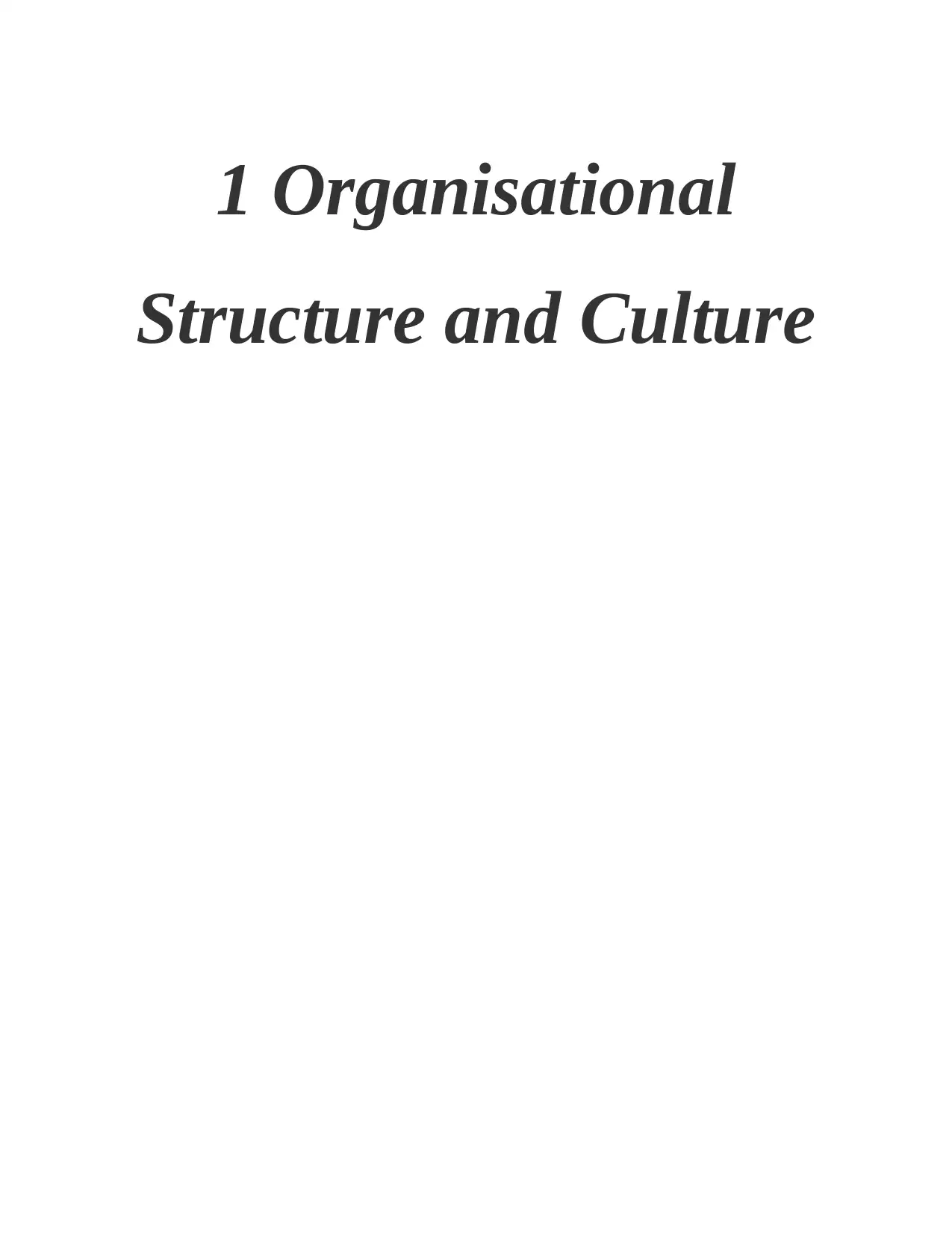
1 Organisational
Structure and Culture
Structure and Culture
Paraphrase This Document
Need a fresh take? Get an instant paraphrase of this document with our AI Paraphraser
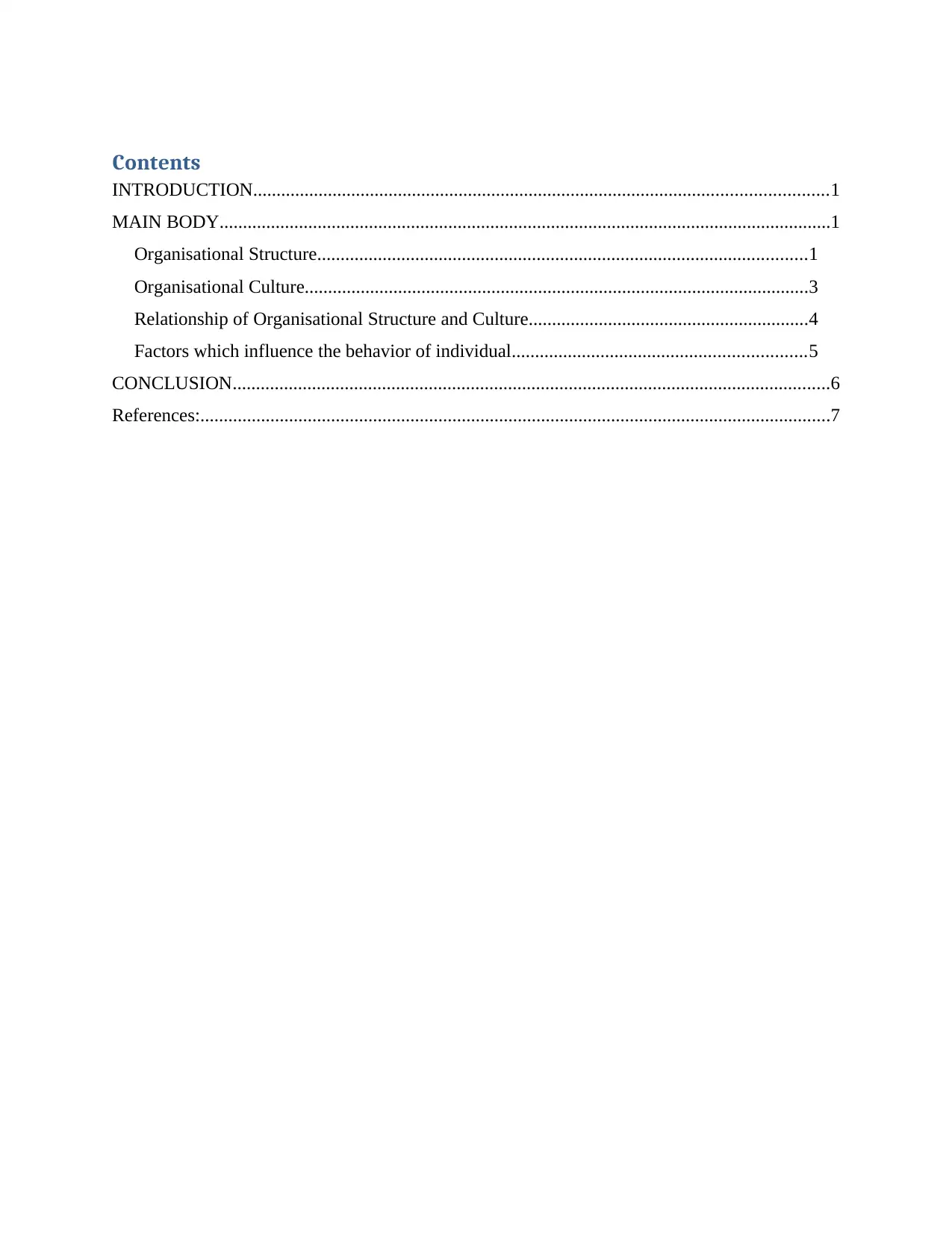
Contents
INTRODUCTION...........................................................................................................................1
MAIN BODY...................................................................................................................................1
Organisational Structure.........................................................................................................1
Organisational Culture............................................................................................................3
Relationship of Organisational Structure and Culture............................................................4
Factors which influence the behavior of individual...............................................................5
CONCLUSION................................................................................................................................6
References:.......................................................................................................................................7
INTRODUCTION...........................................................................................................................1
MAIN BODY...................................................................................................................................1
Organisational Structure.........................................................................................................1
Organisational Culture............................................................................................................3
Relationship of Organisational Structure and Culture............................................................4
Factors which influence the behavior of individual...............................................................5
CONCLUSION................................................................................................................................6
References:.......................................................................................................................................7
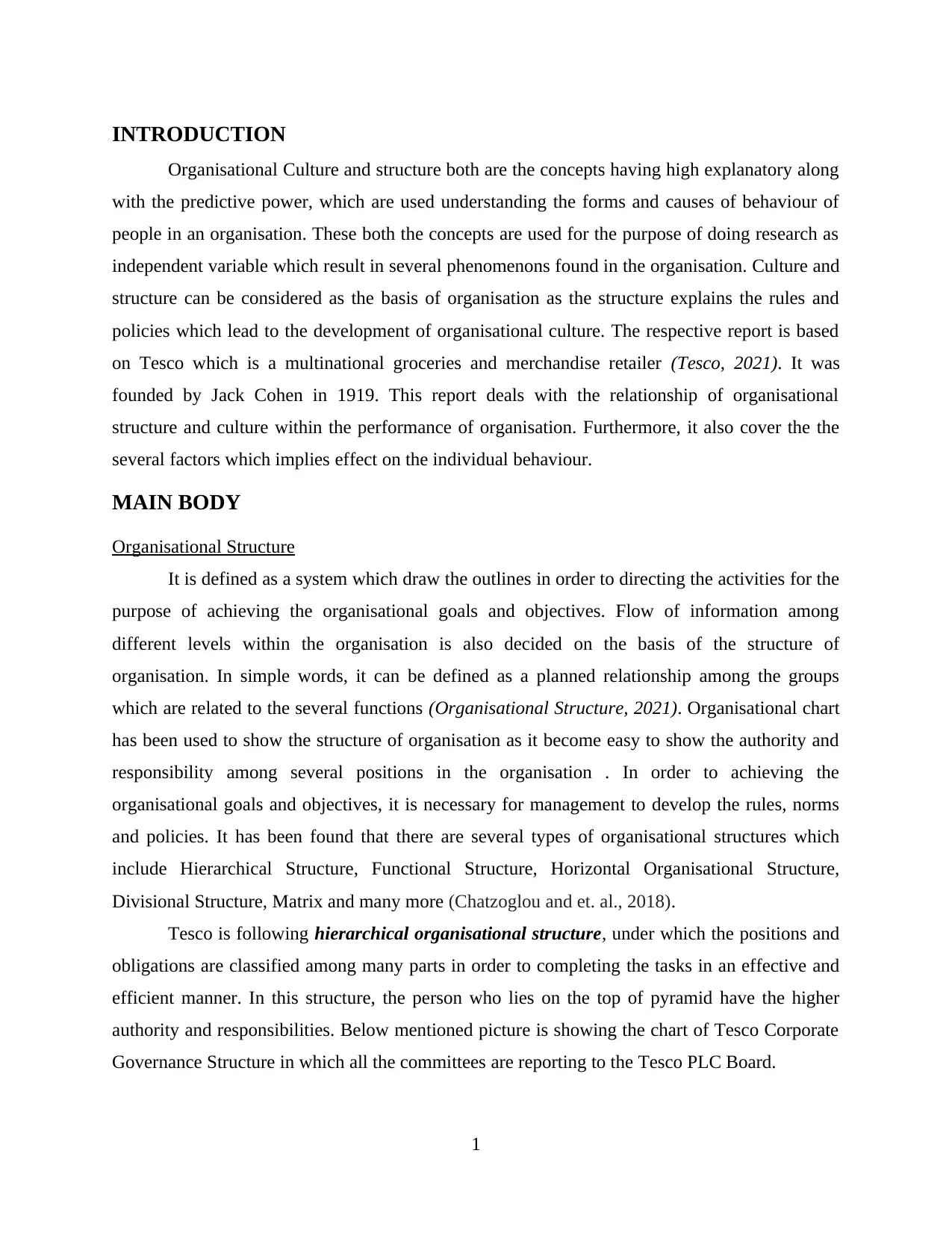
INTRODUCTION
Organisational Culture and structure both are the concepts having high explanatory along
with the predictive power, which are used understanding the forms and causes of behaviour of
people in an organisation. These both the concepts are used for the purpose of doing research as
independent variable which result in several phenomenons found in the organisation. Culture and
structure can be considered as the basis of organisation as the structure explains the rules and
policies which lead to the development of organisational culture. The respective report is based
on Tesco which is a multinational groceries and merchandise retailer (Tesco, 2021). It was
founded by Jack Cohen in 1919. This report deals with the relationship of organisational
structure and culture within the performance of organisation. Furthermore, it also cover the the
several factors which implies effect on the individual behaviour.
MAIN BODY
Organisational Structure
It is defined as a system which draw the outlines in order to directing the activities for the
purpose of achieving the organisational goals and objectives. Flow of information among
different levels within the organisation is also decided on the basis of the structure of
organisation. In simple words, it can be defined as a planned relationship among the groups
which are related to the several functions (Organisational Structure, 2021). Organisational chart
has been used to show the structure of organisation as it become easy to show the authority and
responsibility among several positions in the organisation . In order to achieving the
organisational goals and objectives, it is necessary for management to develop the rules, norms
and policies. It has been found that there are several types of organisational structures which
include Hierarchical Structure, Functional Structure, Horizontal Organisational Structure,
Divisional Structure, Matrix and many more (Chatzoglou and et. al., 2018).
Tesco is following hierarchical organisational structure, under which the positions and
obligations are classified among many parts in order to completing the tasks in an effective and
efficient manner. In this structure, the person who lies on the top of pyramid have the higher
authority and responsibilities. Below mentioned picture is showing the chart of Tesco Corporate
Governance Structure in which all the committees are reporting to the Tesco PLC Board.
1
Organisational Culture and structure both are the concepts having high explanatory along
with the predictive power, which are used understanding the forms and causes of behaviour of
people in an organisation. These both the concepts are used for the purpose of doing research as
independent variable which result in several phenomenons found in the organisation. Culture and
structure can be considered as the basis of organisation as the structure explains the rules and
policies which lead to the development of organisational culture. The respective report is based
on Tesco which is a multinational groceries and merchandise retailer (Tesco, 2021). It was
founded by Jack Cohen in 1919. This report deals with the relationship of organisational
structure and culture within the performance of organisation. Furthermore, it also cover the the
several factors which implies effect on the individual behaviour.
MAIN BODY
Organisational Structure
It is defined as a system which draw the outlines in order to directing the activities for the
purpose of achieving the organisational goals and objectives. Flow of information among
different levels within the organisation is also decided on the basis of the structure of
organisation. In simple words, it can be defined as a planned relationship among the groups
which are related to the several functions (Organisational Structure, 2021). Organisational chart
has been used to show the structure of organisation as it become easy to show the authority and
responsibility among several positions in the organisation . In order to achieving the
organisational goals and objectives, it is necessary for management to develop the rules, norms
and policies. It has been found that there are several types of organisational structures which
include Hierarchical Structure, Functional Structure, Horizontal Organisational Structure,
Divisional Structure, Matrix and many more (Chatzoglou and et. al., 2018).
Tesco is following hierarchical organisational structure, under which the positions and
obligations are classified among many parts in order to completing the tasks in an effective and
efficient manner. In this structure, the person who lies on the top of pyramid have the higher
authority and responsibilities. Below mentioned picture is showing the chart of Tesco Corporate
Governance Structure in which all the committees are reporting to the Tesco PLC Board.
1
You're viewing a preview
Unlock full access by subscribing today!
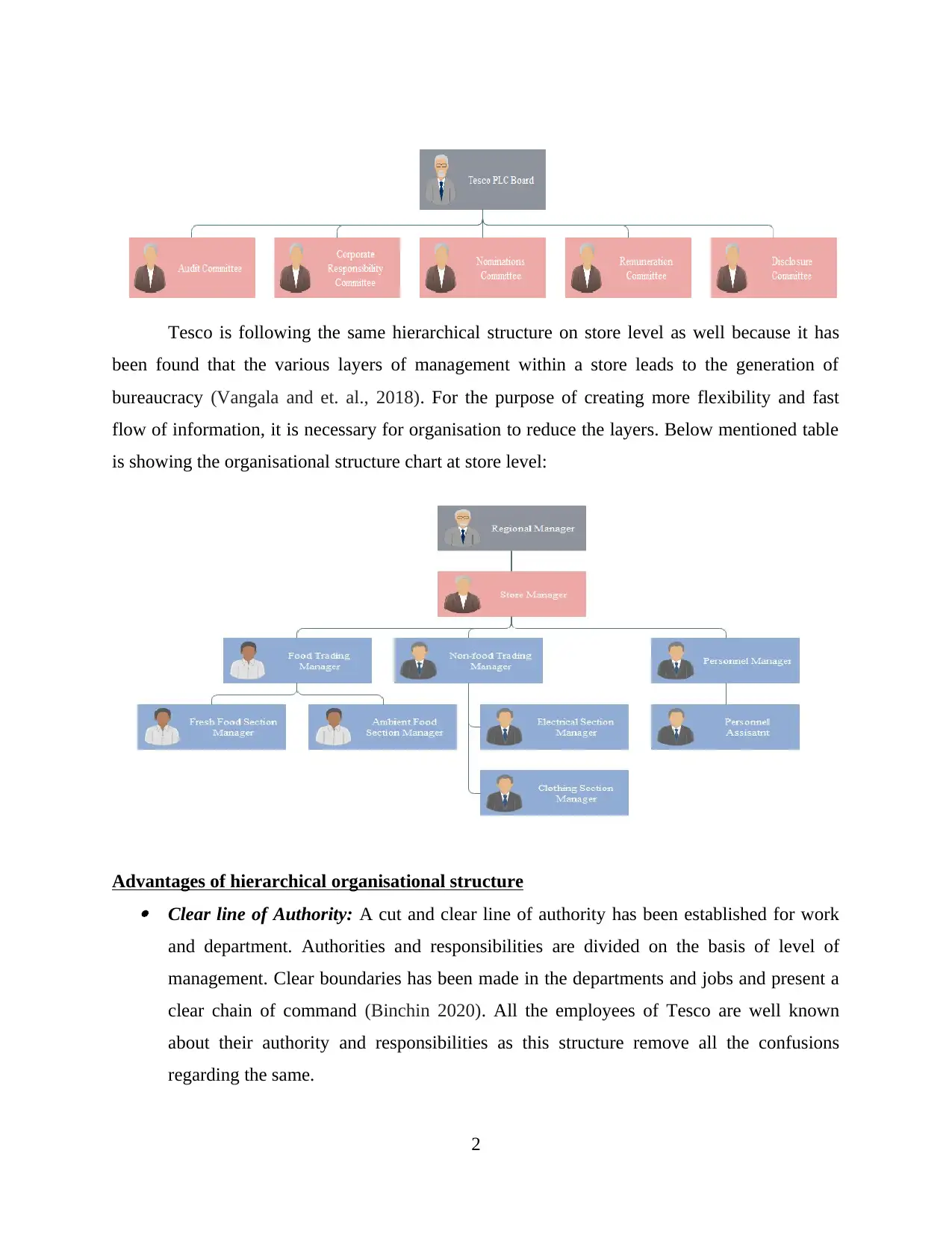
Tesco is following the same hierarchical structure on store level as well because it has
been found that the various layers of management within a store leads to the generation of
bureaucracy (Vangala and et. al., 2018). For the purpose of creating more flexibility and fast
flow of information, it is necessary for organisation to reduce the layers. Below mentioned table
is showing the organisational structure chart at store level:
Advantages of hierarchical organisational structure Clear line of Authority: A cut and clear line of authority has been established for work
and department. Authorities and responsibilities are divided on the basis of level of
management. Clear boundaries has been made in the departments and jobs and present a
clear chain of command (Binchin 2020). All the employees of Tesco are well known
about their authority and responsibilities as this structure remove all the confusions
regarding the same.
2
been found that the various layers of management within a store leads to the generation of
bureaucracy (Vangala and et. al., 2018). For the purpose of creating more flexibility and fast
flow of information, it is necessary for organisation to reduce the layers. Below mentioned table
is showing the organisational structure chart at store level:
Advantages of hierarchical organisational structure Clear line of Authority: A cut and clear line of authority has been established for work
and department. Authorities and responsibilities are divided on the basis of level of
management. Clear boundaries has been made in the departments and jobs and present a
clear chain of command (Binchin 2020). All the employees of Tesco are well known
about their authority and responsibilities as this structure remove all the confusions
regarding the same.
2
Paraphrase This Document
Need a fresh take? Get an instant paraphrase of this document with our AI Paraphraser
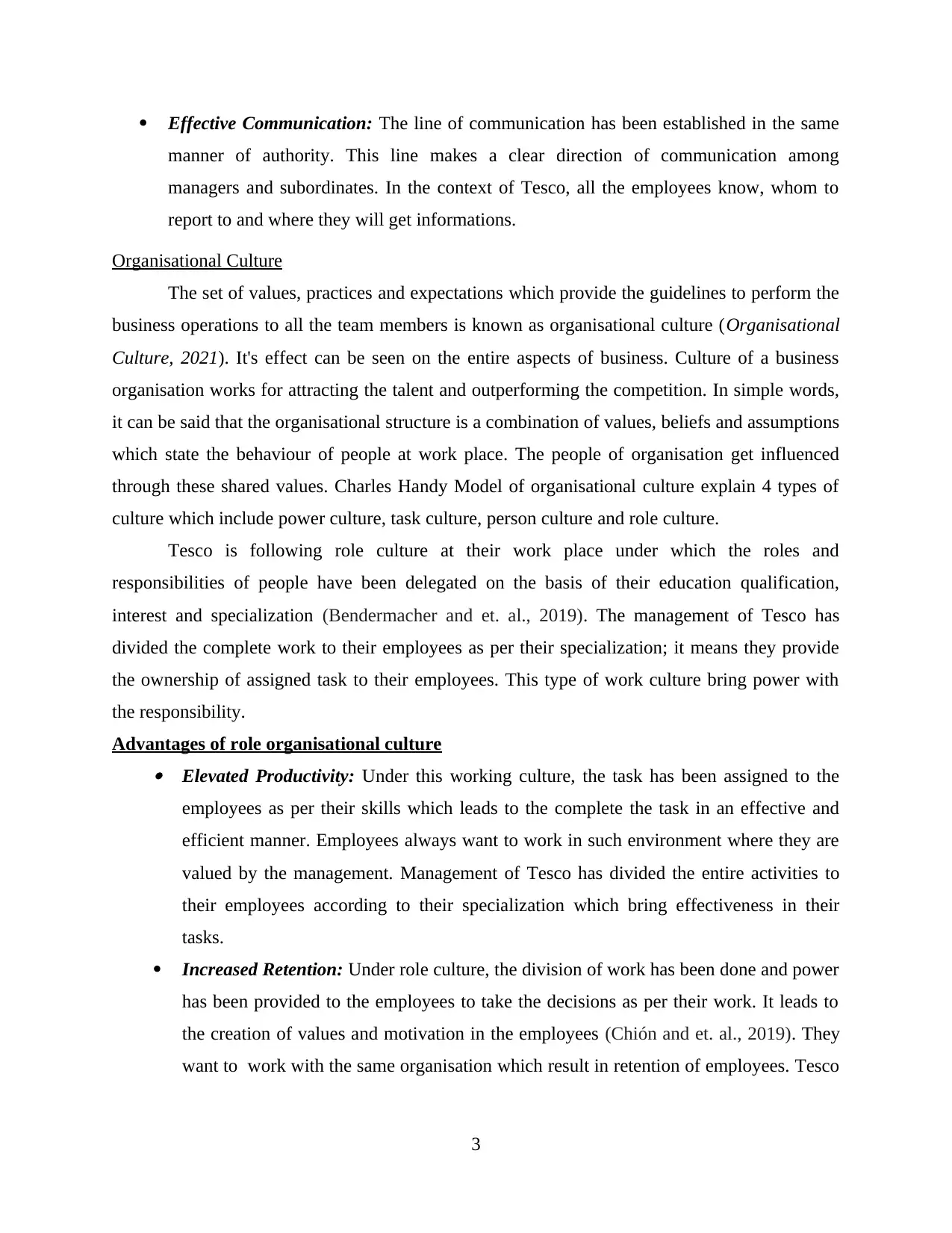
Effective Communication: The line of communication has been established in the same
manner of authority. This line makes a clear direction of communication among
managers and subordinates. In the context of Tesco, all the employees know, whom to
report to and where they will get informations.
Organisational Culture
The set of values, practices and expectations which provide the guidelines to perform the
business operations to all the team members is known as organisational culture (Organisational
Culture, 2021). It's effect can be seen on the entire aspects of business. Culture of a business
organisation works for attracting the talent and outperforming the competition. In simple words,
it can be said that the organisational structure is a combination of values, beliefs and assumptions
which state the behaviour of people at work place. The people of organisation get influenced
through these shared values. Charles Handy Model of organisational culture explain 4 types of
culture which include power culture, task culture, person culture and role culture.
Tesco is following role culture at their work place under which the roles and
responsibilities of people have been delegated on the basis of their education qualification,
interest and specialization (Bendermacher and et. al., 2019). The management of Tesco has
divided the complete work to their employees as per their specialization; it means they provide
the ownership of assigned task to their employees. This type of work culture bring power with
the responsibility.
Advantages of role organisational culture Elevated Productivity: Under this working culture, the task has been assigned to the
employees as per their skills which leads to the complete the task in an effective and
efficient manner. Employees always want to work in such environment where they are
valued by the management. Management of Tesco has divided the entire activities to
their employees according to their specialization which bring effectiveness in their
tasks.
Increased Retention: Under role culture, the division of work has been done and power
has been provided to the employees to take the decisions as per their work. It leads to
the creation of values and motivation in the employees (Chión and et. al., 2019). They
want to work with the same organisation which result in retention of employees. Tesco
3
manner of authority. This line makes a clear direction of communication among
managers and subordinates. In the context of Tesco, all the employees know, whom to
report to and where they will get informations.
Organisational Culture
The set of values, practices and expectations which provide the guidelines to perform the
business operations to all the team members is known as organisational culture (Organisational
Culture, 2021). It's effect can be seen on the entire aspects of business. Culture of a business
organisation works for attracting the talent and outperforming the competition. In simple words,
it can be said that the organisational structure is a combination of values, beliefs and assumptions
which state the behaviour of people at work place. The people of organisation get influenced
through these shared values. Charles Handy Model of organisational culture explain 4 types of
culture which include power culture, task culture, person culture and role culture.
Tesco is following role culture at their work place under which the roles and
responsibilities of people have been delegated on the basis of their education qualification,
interest and specialization (Bendermacher and et. al., 2019). The management of Tesco has
divided the complete work to their employees as per their specialization; it means they provide
the ownership of assigned task to their employees. This type of work culture bring power with
the responsibility.
Advantages of role organisational culture Elevated Productivity: Under this working culture, the task has been assigned to the
employees as per their skills which leads to the complete the task in an effective and
efficient manner. Employees always want to work in such environment where they are
valued by the management. Management of Tesco has divided the entire activities to
their employees according to their specialization which bring effectiveness in their
tasks.
Increased Retention: Under role culture, the division of work has been done and power
has been provided to the employees to take the decisions as per their work. It leads to
the creation of values and motivation in the employees (Chión and et. al., 2019). They
want to work with the same organisation which result in retention of employees. Tesco
3
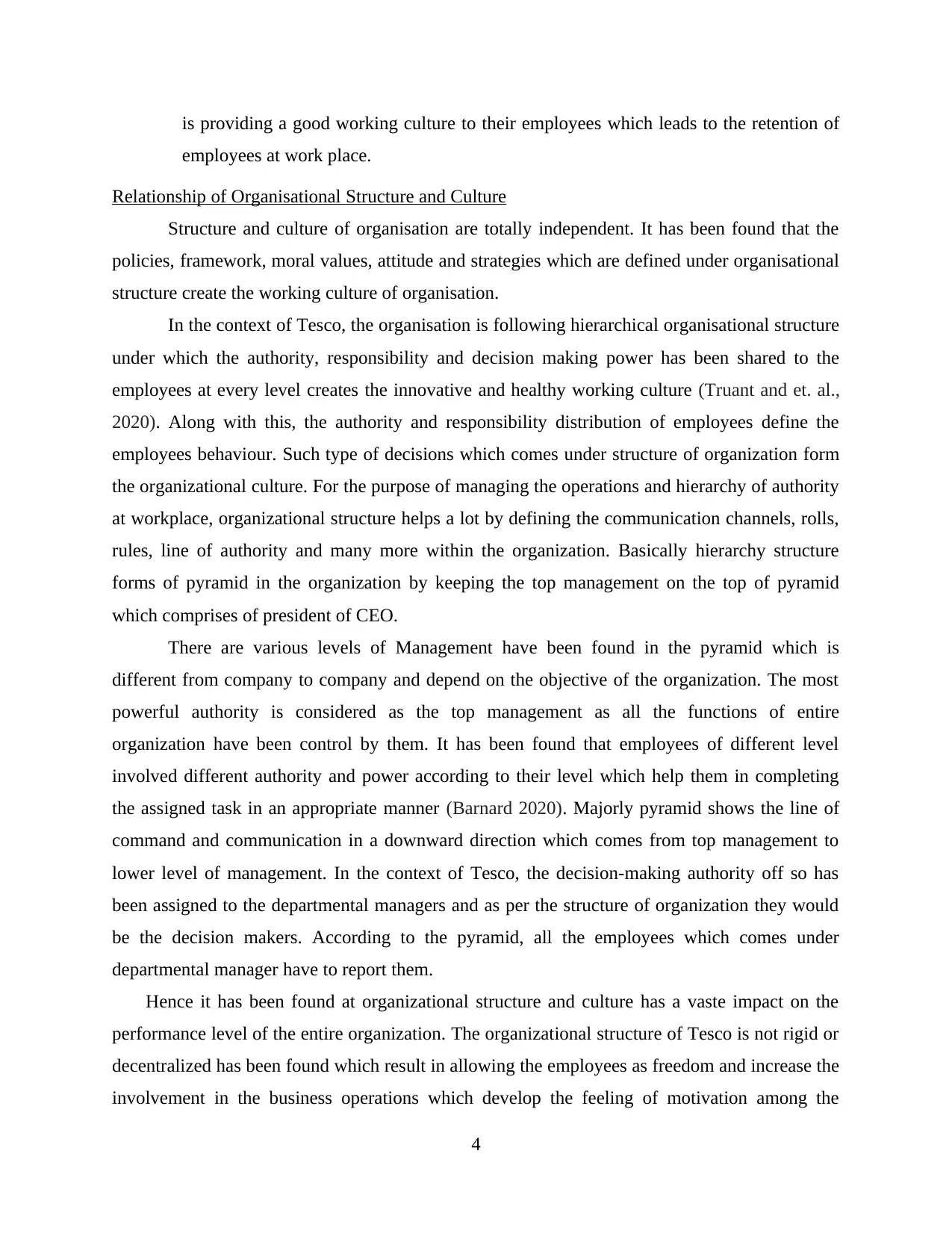
is providing a good working culture to their employees which leads to the retention of
employees at work place.
Relationship of Organisational Structure and Culture
Structure and culture of organisation are totally independent. It has been found that the
policies, framework, moral values, attitude and strategies which are defined under organisational
structure create the working culture of organisation.
In the context of Tesco, the organisation is following hierarchical organisational structure
under which the authority, responsibility and decision making power has been shared to the
employees at every level creates the innovative and healthy working culture (Truant and et. al.,
2020). Along with this, the authority and responsibility distribution of employees define the
employees behaviour. Such type of decisions which comes under structure of organization form
the organizational culture. For the purpose of managing the operations and hierarchy of authority
at workplace, organizational structure helps a lot by defining the communication channels, rolls,
rules, line of authority and many more within the organization. Basically hierarchy structure
forms of pyramid in the organization by keeping the top management on the top of pyramid
which comprises of president of CEO.
There are various levels of Management have been found in the pyramid which is
different from company to company and depend on the objective of the organization. The most
powerful authority is considered as the top management as all the functions of entire
organization have been control by them. It has been found that employees of different level
involved different authority and power according to their level which help them in completing
the assigned task in an appropriate manner (Barnard 2020). Majorly pyramid shows the line of
command and communication in a downward direction which comes from top management to
lower level of management. In the context of Tesco, the decision-making authority off so has
been assigned to the departmental managers and as per the structure of organization they would
be the decision makers. According to the pyramid, all the employees which comes under
departmental manager have to report them.
Hence it has been found at organizational structure and culture has a vaste impact on the
performance level of the entire organization. The organizational structure of Tesco is not rigid or
decentralized has been found which result in allowing the employees as freedom and increase the
involvement in the business operations which develop the feeling of motivation among the
4
employees at work place.
Relationship of Organisational Structure and Culture
Structure and culture of organisation are totally independent. It has been found that the
policies, framework, moral values, attitude and strategies which are defined under organisational
structure create the working culture of organisation.
In the context of Tesco, the organisation is following hierarchical organisational structure
under which the authority, responsibility and decision making power has been shared to the
employees at every level creates the innovative and healthy working culture (Truant and et. al.,
2020). Along with this, the authority and responsibility distribution of employees define the
employees behaviour. Such type of decisions which comes under structure of organization form
the organizational culture. For the purpose of managing the operations and hierarchy of authority
at workplace, organizational structure helps a lot by defining the communication channels, rolls,
rules, line of authority and many more within the organization. Basically hierarchy structure
forms of pyramid in the organization by keeping the top management on the top of pyramid
which comprises of president of CEO.
There are various levels of Management have been found in the pyramid which is
different from company to company and depend on the objective of the organization. The most
powerful authority is considered as the top management as all the functions of entire
organization have been control by them. It has been found that employees of different level
involved different authority and power according to their level which help them in completing
the assigned task in an appropriate manner (Barnard 2020). Majorly pyramid shows the line of
command and communication in a downward direction which comes from top management to
lower level of management. In the context of Tesco, the decision-making authority off so has
been assigned to the departmental managers and as per the structure of organization they would
be the decision makers. According to the pyramid, all the employees which comes under
departmental manager have to report them.
Hence it has been found at organizational structure and culture has a vaste impact on the
performance level of the entire organization. The organizational structure of Tesco is not rigid or
decentralized has been found which result in allowing the employees as freedom and increase the
involvement in the business operations which develop the feeling of motivation among the
4
You're viewing a preview
Unlock full access by subscribing today!
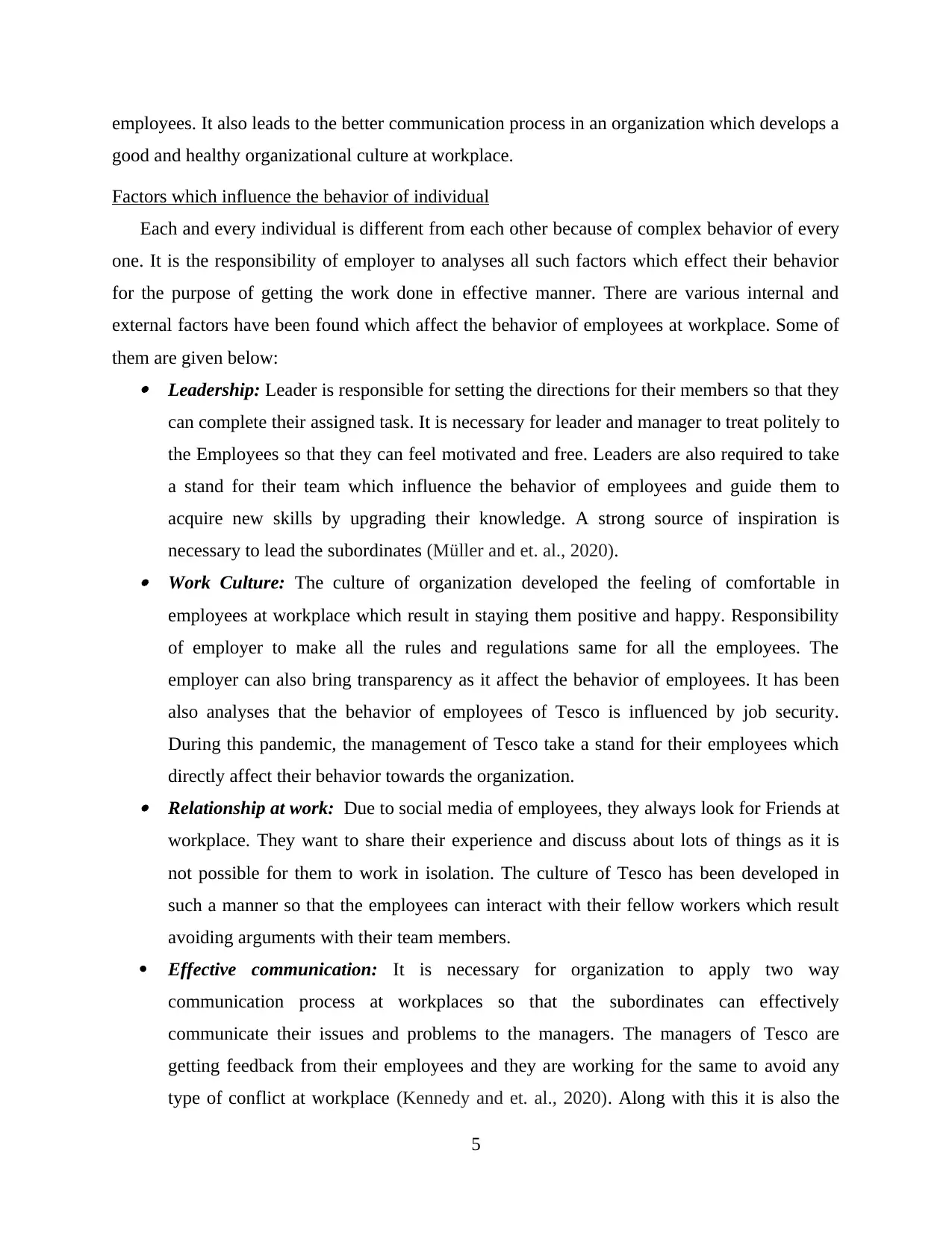
employees. It also leads to the better communication process in an organization which develops a
good and healthy organizational culture at workplace.
Factors which influence the behavior of individual
Each and every individual is different from each other because of complex behavior of every
one. It is the responsibility of employer to analyses all such factors which effect their behavior
for the purpose of getting the work done in effective manner. There are various internal and
external factors have been found which affect the behavior of employees at workplace. Some of
them are given below: Leadership: Leader is responsible for setting the directions for their members so that they
can complete their assigned task. It is necessary for leader and manager to treat politely to
the Employees so that they can feel motivated and free. Leaders are also required to take
a stand for their team which influence the behavior of employees and guide them to
acquire new skills by upgrading their knowledge. A strong source of inspiration is
necessary to lead the subordinates (Müller and et. al., 2020). Work Culture: The culture of organization developed the feeling of comfortable in
employees at workplace which result in staying them positive and happy. Responsibility
of employer to make all the rules and regulations same for all the employees. The
employer can also bring transparency as it affect the behavior of employees. It has been
also analyses that the behavior of employees of Tesco is influenced by job security.
During this pandemic, the management of Tesco take a stand for their employees which
directly affect their behavior towards the organization. Relationship at work: Due to social media of employees, they always look for Friends at
workplace. They want to share their experience and discuss about lots of things as it is
not possible for them to work in isolation. The culture of Tesco has been developed in
such a manner so that the employees can interact with their fellow workers which result
avoiding arguments with their team members.
Effective communication: It is necessary for organization to apply two way
communication process at workplaces so that the subordinates can effectively
communicate their issues and problems to the managers. The managers of Tesco are
getting feedback from their employees and they are working for the same to avoid any
type of conflict at workplace (Kennedy and et. al., 2020). Along with this it is also the
5
good and healthy organizational culture at workplace.
Factors which influence the behavior of individual
Each and every individual is different from each other because of complex behavior of every
one. It is the responsibility of employer to analyses all such factors which effect their behavior
for the purpose of getting the work done in effective manner. There are various internal and
external factors have been found which affect the behavior of employees at workplace. Some of
them are given below: Leadership: Leader is responsible for setting the directions for their members so that they
can complete their assigned task. It is necessary for leader and manager to treat politely to
the Employees so that they can feel motivated and free. Leaders are also required to take
a stand for their team which influence the behavior of employees and guide them to
acquire new skills by upgrading their knowledge. A strong source of inspiration is
necessary to lead the subordinates (Müller and et. al., 2020). Work Culture: The culture of organization developed the feeling of comfortable in
employees at workplace which result in staying them positive and happy. Responsibility
of employer to make all the rules and regulations same for all the employees. The
employer can also bring transparency as it affect the behavior of employees. It has been
also analyses that the behavior of employees of Tesco is influenced by job security.
During this pandemic, the management of Tesco take a stand for their employees which
directly affect their behavior towards the organization. Relationship at work: Due to social media of employees, they always look for Friends at
workplace. They want to share their experience and discuss about lots of things as it is
not possible for them to work in isolation. The culture of Tesco has been developed in
such a manner so that the employees can interact with their fellow workers which result
avoiding arguments with their team members.
Effective communication: It is necessary for organization to apply two way
communication process at workplaces so that the subordinates can effectively
communicate their issues and problems to the managers. The managers of Tesco are
getting feedback from their employees and they are working for the same to avoid any
type of conflict at workplace (Kennedy and et. al., 2020). Along with this it is also the
5
Paraphrase This Document
Need a fresh take? Get an instant paraphrase of this document with our AI Paraphraser
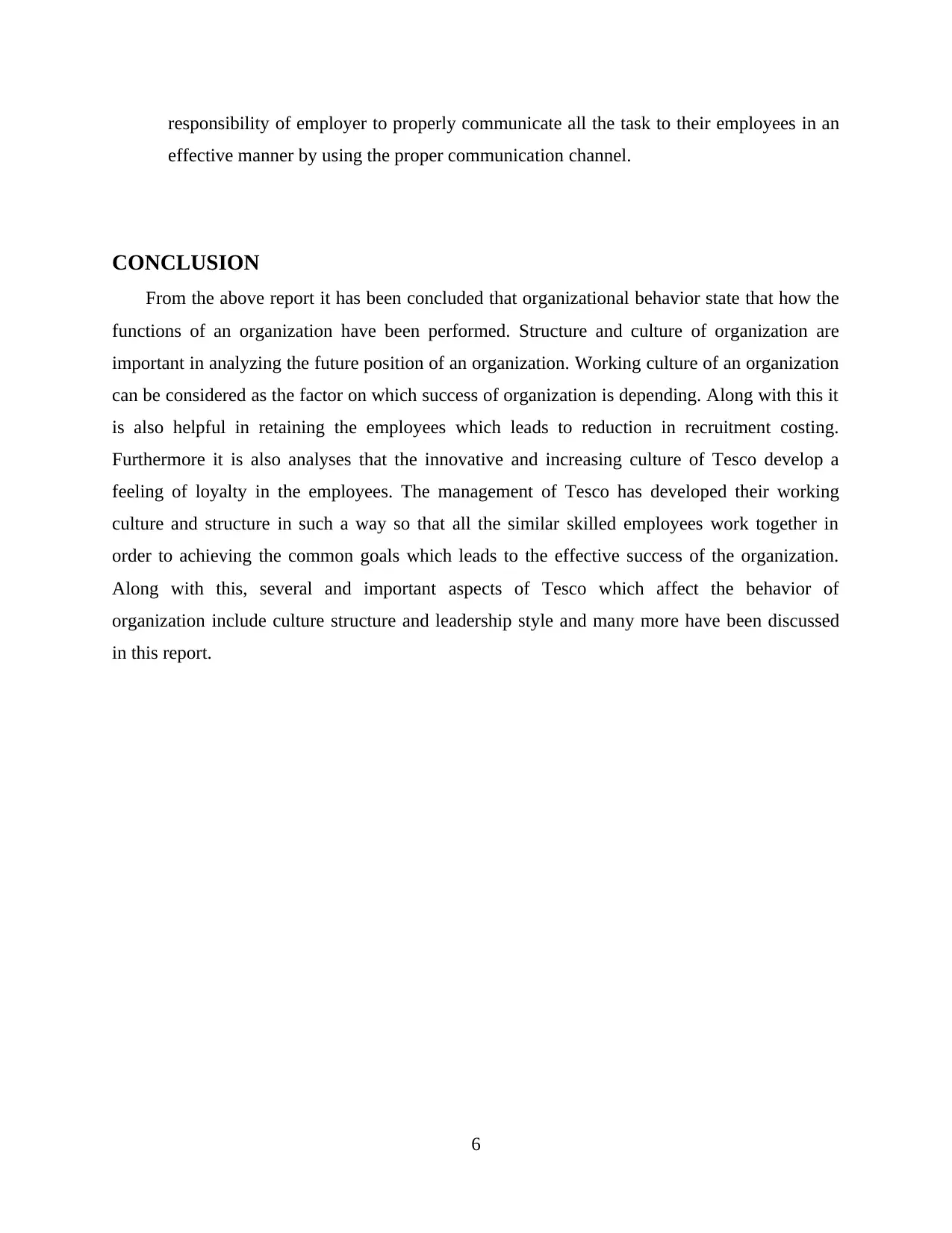
responsibility of employer to properly communicate all the task to their employees in an
effective manner by using the proper communication channel.
CONCLUSION
From the above report it has been concluded that organizational behavior state that how the
functions of an organization have been performed. Structure and culture of organization are
important in analyzing the future position of an organization. Working culture of an organization
can be considered as the factor on which success of organization is depending. Along with this it
is also helpful in retaining the employees which leads to reduction in recruitment costing.
Furthermore it is also analyses that the innovative and increasing culture of Tesco develop a
feeling of loyalty in the employees. The management of Tesco has developed their working
culture and structure in such a way so that all the similar skilled employees work together in
order to achieving the common goals which leads to the effective success of the organization.
Along with this, several and important aspects of Tesco which affect the behavior of
organization include culture structure and leadership style and many more have been discussed
in this report.
6
effective manner by using the proper communication channel.
CONCLUSION
From the above report it has been concluded that organizational behavior state that how the
functions of an organization have been performed. Structure and culture of organization are
important in analyzing the future position of an organization. Working culture of an organization
can be considered as the factor on which success of organization is depending. Along with this it
is also helpful in retaining the employees which leads to reduction in recruitment costing.
Furthermore it is also analyses that the innovative and increasing culture of Tesco develop a
feeling of loyalty in the employees. The management of Tesco has developed their working
culture and structure in such a way so that all the similar skilled employees work together in
order to achieving the common goals which leads to the effective success of the organization.
Along with this, several and important aspects of Tesco which affect the behavior of
organization include culture structure and leadership style and many more have been discussed
in this report.
6
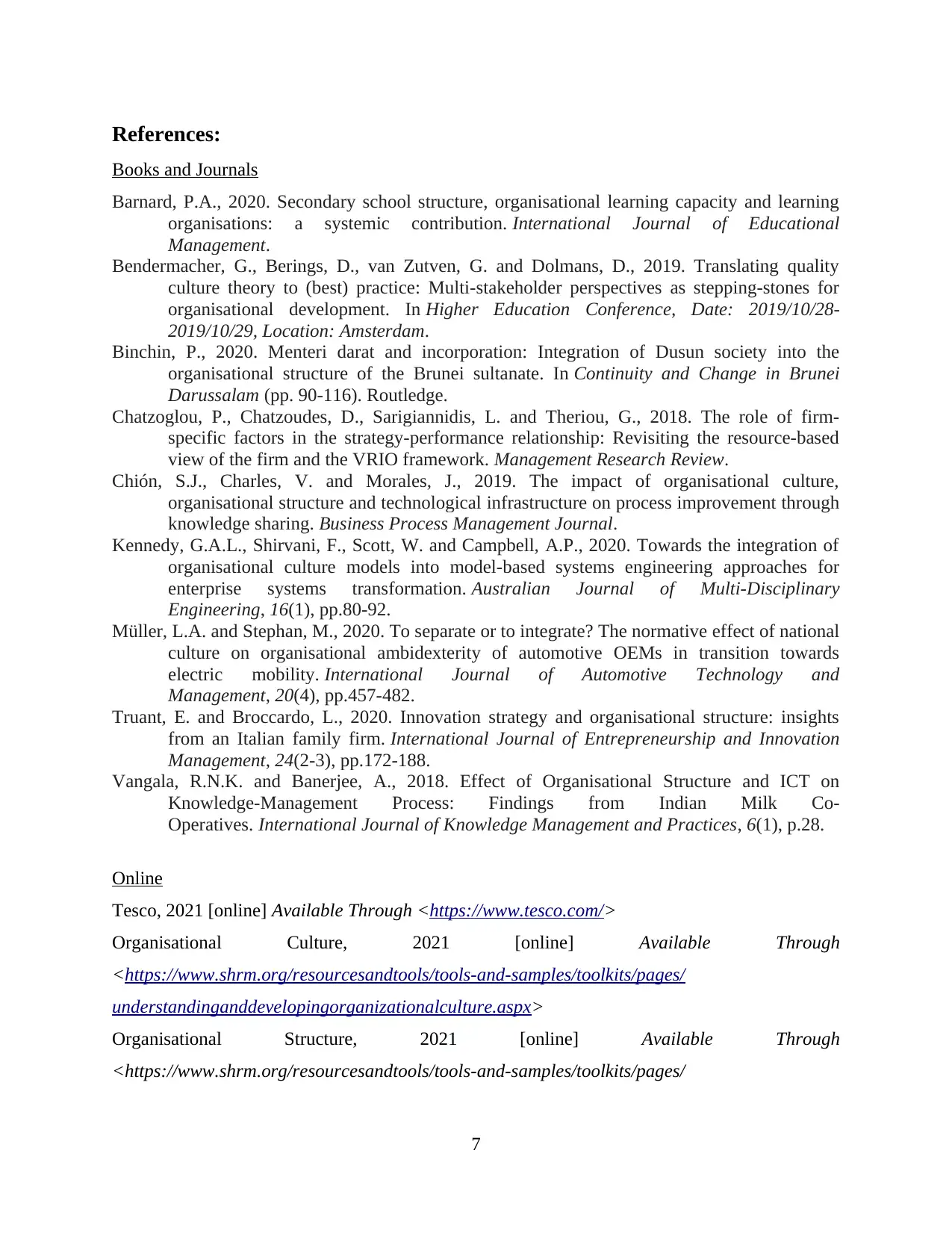
References:
Books and Journals
Barnard, P.A., 2020. Secondary school structure, organisational learning capacity and learning
organisations: a systemic contribution. International Journal of Educational
Management.
Bendermacher, G., Berings, D., van Zutven, G. and Dolmans, D., 2019. Translating quality
culture theory to (best) practice: Multi-stakeholder perspectives as stepping-stones for
organisational development. In Higher Education Conference, Date: 2019/10/28-
2019/10/29, Location: Amsterdam.
Binchin, P., 2020. Menteri darat and incorporation: Integration of Dusun society into the
organisational structure of the Brunei sultanate. In Continuity and Change in Brunei
Darussalam (pp. 90-116). Routledge.
Chatzoglou, P., Chatzoudes, D., Sarigiannidis, L. and Theriou, G., 2018. The role of firm-
specific factors in the strategy-performance relationship: Revisiting the resource-based
view of the firm and the VRIO framework. Management Research Review.
Chión, S.J., Charles, V. and Morales, J., 2019. The impact of organisational culture,
organisational structure and technological infrastructure on process improvement through
knowledge sharing. Business Process Management Journal.
Kennedy, G.A.L., Shirvani, F., Scott, W. and Campbell, A.P., 2020. Towards the integration of
organisational culture models into model-based systems engineering approaches for
enterprise systems transformation. Australian Journal of Multi-Disciplinary
Engineering, 16(1), pp.80-92.
Müller, L.A. and Stephan, M., 2020. To separate or to integrate? The normative effect of national
culture on organisational ambidexterity of automotive OEMs in transition towards
electric mobility. International Journal of Automotive Technology and
Management, 20(4), pp.457-482.
Truant, E. and Broccardo, L., 2020. Innovation strategy and organisational structure: insights
from an Italian family firm. International Journal of Entrepreneurship and Innovation
Management, 24(2-3), pp.172-188.
Vangala, R.N.K. and Banerjee, A., 2018. Effect of Organisational Structure and ICT on
Knowledge-Management Process: Findings from Indian Milk Co-
Operatives. International Journal of Knowledge Management and Practices, 6(1), p.28.
Online
Tesco, 2021 [online] Available Through <https://www.tesco.com/>
Organisational Culture, 2021 [online] Available Through
<https://www.shrm.org/resourcesandtools/tools-and-samples/toolkits/pages/
understandinganddevelopingorganizationalculture.aspx>
Organisational Structure, 2021 [online] Available Through
<https://www.shrm.org/resourcesandtools/tools-and-samples/toolkits/pages/
7
Books and Journals
Barnard, P.A., 2020. Secondary school structure, organisational learning capacity and learning
organisations: a systemic contribution. International Journal of Educational
Management.
Bendermacher, G., Berings, D., van Zutven, G. and Dolmans, D., 2019. Translating quality
culture theory to (best) practice: Multi-stakeholder perspectives as stepping-stones for
organisational development. In Higher Education Conference, Date: 2019/10/28-
2019/10/29, Location: Amsterdam.
Binchin, P., 2020. Menteri darat and incorporation: Integration of Dusun society into the
organisational structure of the Brunei sultanate. In Continuity and Change in Brunei
Darussalam (pp. 90-116). Routledge.
Chatzoglou, P., Chatzoudes, D., Sarigiannidis, L. and Theriou, G., 2018. The role of firm-
specific factors in the strategy-performance relationship: Revisiting the resource-based
view of the firm and the VRIO framework. Management Research Review.
Chión, S.J., Charles, V. and Morales, J., 2019. The impact of organisational culture,
organisational structure and technological infrastructure on process improvement through
knowledge sharing. Business Process Management Journal.
Kennedy, G.A.L., Shirvani, F., Scott, W. and Campbell, A.P., 2020. Towards the integration of
organisational culture models into model-based systems engineering approaches for
enterprise systems transformation. Australian Journal of Multi-Disciplinary
Engineering, 16(1), pp.80-92.
Müller, L.A. and Stephan, M., 2020. To separate or to integrate? The normative effect of national
culture on organisational ambidexterity of automotive OEMs in transition towards
electric mobility. International Journal of Automotive Technology and
Management, 20(4), pp.457-482.
Truant, E. and Broccardo, L., 2020. Innovation strategy and organisational structure: insights
from an Italian family firm. International Journal of Entrepreneurship and Innovation
Management, 24(2-3), pp.172-188.
Vangala, R.N.K. and Banerjee, A., 2018. Effect of Organisational Structure and ICT on
Knowledge-Management Process: Findings from Indian Milk Co-
Operatives. International Journal of Knowledge Management and Practices, 6(1), p.28.
Online
Tesco, 2021 [online] Available Through <https://www.tesco.com/>
Organisational Culture, 2021 [online] Available Through
<https://www.shrm.org/resourcesandtools/tools-and-samples/toolkits/pages/
understandinganddevelopingorganizationalculture.aspx>
Organisational Structure, 2021 [online] Available Through
<https://www.shrm.org/resourcesandtools/tools-and-samples/toolkits/pages/
7
You're viewing a preview
Unlock full access by subscribing today!
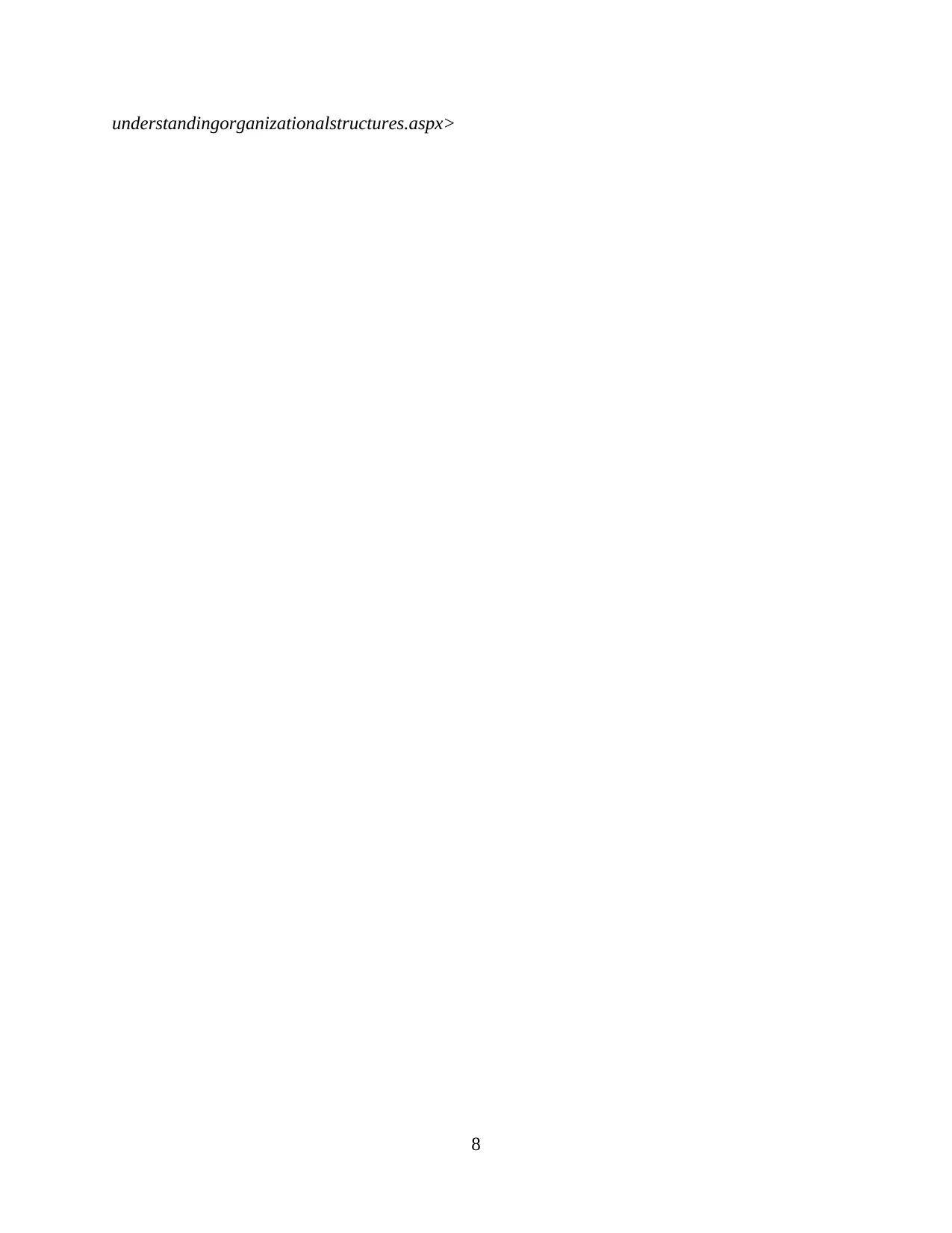
understandingorganizationalstructures.aspx>
8
8
1 out of 10
Related Documents
Your All-in-One AI-Powered Toolkit for Academic Success.
+13062052269
info@desklib.com
Available 24*7 on WhatsApp / Email
![[object Object]](/_next/static/media/star-bottom.7253800d.svg)
Unlock your academic potential
© 2024 | Zucol Services PVT LTD | All rights reserved.



